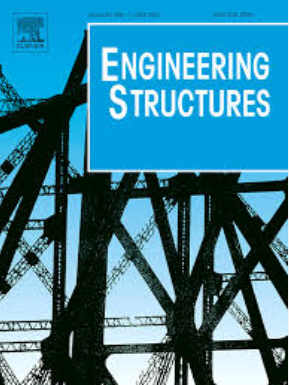Out-of-plane monotonic testing and fragility function development of screw and adhesive connections of steel-framed gypsum-board panels
IF 5.6
1区 工程技术
Q1 ENGINEERING, CIVIL
引用次数: 0
Abstract
Extensive evidence indicates that steel-frame (SF) gypsum-board (GB) partitions are susceptible to seismic damage from very small story drift ratio (SDR) demands, which can lead to significant economic losses, environmental impacts, and downtime in buildings. To mitigate this risk, several innovations have been developed in SF-GB partitions, among which the use of adhesive connections (ACs) recently stands out as a replacement strategy to screw connections (SCs) for attaching GBs to SFs. The use of ACs has shown significant increments in both strength and stiffness of partitions, compared to partitions with SCs. However, the behavior of ACs has been studied mainly under in-plane loads and without a detailed analysis of the use of ACs in the reduction of damage states (DSs) neither the generation of fragility curves. This research presents an experimental study of 36 full-scale SF-GB panels, where the structural behavior under out-of-plane loads of SC-SF-GB and AC-SF-GB panels, as well as other design variables such as GB thickness and type of SF, are assessed and compared in terms of strength, stiffness, and DS evolution. The results of the test campaign show that the mean strength and stiffness of AC-SF-GB panels are 101 % and 47 % higher than those of the SC-SF-GB panels, respectively. In addition, AC-SF-GB panels exhibit a better performance compared to SC-SF-GB panels in terms of DS evolution. The results indicate that the type of connection is a design variable with significant impact on the strength, stiffness, and damage evolution of partitions, over the GB thickness and the type of SF. Finally, the developed fragility functions, which pass the goodness-of-fit tests, confirm the enhanced seismic performance of the AC-GB-SF panels and are a key component to perform future loss estimation studies for building-specific assessments.
求助全文
约1分钟内获得全文
求助全文
来源期刊

Engineering Structures
工程技术-工程:土木
CiteScore
10.20
自引率
14.50%
发文量
1385
审稿时长
67 days
期刊介绍:
Engineering Structures provides a forum for a broad blend of scientific and technical papers to reflect the evolving needs of the structural engineering and structural mechanics communities. Particularly welcome are contributions dealing with applications of structural engineering and mechanics principles in all areas of technology. The journal aspires to a broad and integrated coverage of the effects of dynamic loadings and of the modelling techniques whereby the structural response to these loadings may be computed.
The scope of Engineering Structures encompasses, but is not restricted to, the following areas: infrastructure engineering; earthquake engineering; structure-fluid-soil interaction; wind engineering; fire engineering; blast engineering; structural reliability/stability; life assessment/integrity; structural health monitoring; multi-hazard engineering; structural dynamics; optimization; expert systems; experimental modelling; performance-based design; multiscale analysis; value engineering.
Topics of interest include: tall buildings; innovative structures; environmentally responsive structures; bridges; stadiums; commercial and public buildings; transmission towers; television and telecommunication masts; foldable structures; cooling towers; plates and shells; suspension structures; protective structures; smart structures; nuclear reactors; dams; pressure vessels; pipelines; tunnels.
Engineering Structures also publishes review articles, short communications and discussions, book reviews, and a diary on international events related to any aspect of structural engineering.
 求助内容:
求助内容: 应助结果提醒方式:
应助结果提醒方式:


